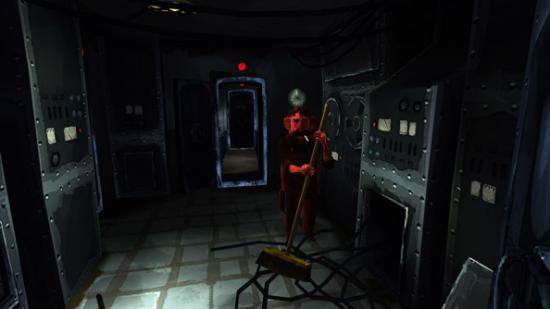Hello, Spotlighters! I’m Mr Peel; Mr Benson isn’t in today. In accordance with the dark arts of supply teaching, I won’t tell you where he is, but will grimace in such a way as to suggest he’s off gallivanting somewhere nice and warm. I do, however, encourage you to refer to his notes. As ever, we’ll be affixing a yellow light to a green light to produce a teal shade of criticism on one of the most interesting games currently vying for a place on Steam.
Signal Ops is Rainbow Six for silly people. In this multi-perspective tactical FPS, you’re tasked with seeing simultaneously through the eyes of up to four agents dedicated to rooting out heresy in the name of Him Below. In navigating a series of Deus Ex-styled open levels on the quiet, you will attempt to think in four places at once. You will not succeed. But you will have four times the minimum legal limit of good fun.
Here’s an odd thing about games and British humour, in inverted commas: bar Lionhead’s last decade of work, it’s remained the preserve of men and women across the Pacific. So it is that a bunch of Canadians are responsible for Signal Ops’ distinctly Monty Pythagonal premise. Succinctly put, its schtick is ‘50s British bureaucracy as applied to the (never explicitly named) devil’s work; its backdrop, a tongue-in-cheek lo-fi dystopia in which church and governance are too-closely intertwined.
From an underground bunker studded with LED lights and bleeping control panels, you’ll guide your team through the Greatest Hits of espionage: evidence-planting, secret-stealing, sabotage and assassination. While a range of line-of-sight commands allow for basic ‘follow’, ‘find cover’ or ‘attack’ orders, you’ll need to alternate between your agents directly for more nuanced movement. It’s here Signal Ops channels the original Deus Ex, asking you to creep about cautiously with the assistance of a lean key, planting a pistol between the shoulder blades of a plodding policeman when necessary.
Shooting is perfunctory, and that’s really no criticism – it’s just one tool in your Mephistophelian armoury. The others are divvied between the game’s classes, which include the Wrench (enemy of alarm stations and stubborn gates), Demo (explosive trap specialist), Spy (scout and conversationalist) and Bolt. It’s the latter who justifies the ‘Signal’ in the game’s title and proves most crucial in the field, lugging about the battery-powered radar that prevents your display from descending into TV noise.
Signal Ops’ screens-within-screens UI is supremely odd, and takes some getting used to – it mostly closely resembles Ultima Underworld, a game released in a time when 3D worlds could only be rendered in tiny boxes. Relinquishing control of your troops and literally stepping away from the in-bunker monitor is even odder. And In a cute touch, the menu screen presents you with a third feed – that of the CCTV cameras recording you. Nothing goes unseen by the devil and his disciples.
The game is absolutely at its best when remembering to save frequently, and to reach for the ‘Reinforcement’ command before the ‘Quickload’ key. A steep learning curve can lead to frustration, but players will have the most fun when accepting the resulting shootouts and allowing Signal Ops to become the chaotic possibility space it threatens to be.
At its worst, it can feel like the poorer moments of quadrilateral platformer Thomas Was Alone. You’ll send one character forward, only to encounter a class-specific barrier and be forced to send another tailing after them at a slow waddle. These through-the-motions sequences aren’t helped by the fact that agents forget to stay crouched as soon as you leave them to their own devices, instead standing vacantly in the potential line of sight of enemy guards.
The games Signal Ops seeks to mimic are notoriously expensive to make and difficult to bankroll. While the rise of indie has given a great tectonic shunt to the latter point, the former still stands, and – though it’s churlish to say so – Ops certainly isn’t everything it could have been with a team of 100. Coming to this game after a return to Dunwall, I miss the verticality and polish. An inspired art style can’t cover for the simplistic AI, nor the frequent occasions on which an agent’s head goes right through the walls.
That said, with a team of 100 Signal Ops simply wouldn’t have been made, and we wouldn’t have this often ace espionage FPS – a slapstick Mission Impossible in which the suave Spy sweet-talking the guards can be juxtaposed by curious civilians bumping mutely against a supposedly hidden radio-man.
What’s more, developers Space Bullet Dynamics Corporation have been quick to patch since I first played the game on its April GOG.com release, crunching to eliminate bugs at the expense of promotion. Their efforts, along with my burning, selfish need to try out the co-operative mode with Steam friends, have more than earned Signal Ops its long-awaited push through Greenlight. Get to it!
